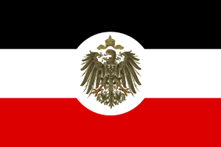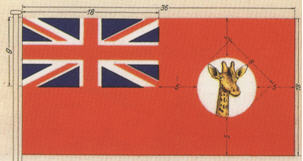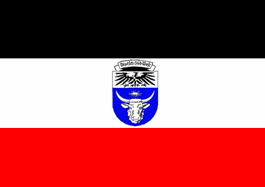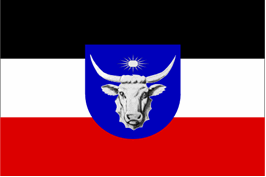|
The Colonial Flag Proposals of Wilhelm Solf
The German Empire, which was created in 1871 in Versailles, initially was not very inclined to establish its own colonies. Reichs-Chancellor Bismarck especially was against such plans because he was afraid of complications regarding the foreign policy. However, by 1884 everything seemed suitable and Germany step-by-step occupied some areas in Africa and Oceania, those being Cameroon, Southwest-Africa, East-Africa, Togo, Samoa and parts of New Guinea.
Unlike other European countries like Great Britain, the German Empire at first did not have much interest in creating special flags for their colonies. Although the Empire adopted some flags for the Reichskolonialamt (Office for the colonies) and other official institutions in 1893, these flags did not contain any elements that accentuated their connection to any particular colony.

Flag for the Foreign office
Reichskolonialamt since 1893 The Secretary of State of the Reichskolonialamt (Foriegn Office), Wilhelm Solf, in the years 1912 and 1913 made a tour of inspection through the German "Schutzgebiete" (areas of protection), as the colonies were called by Germany. During this visit he was also allowed to go to some British colonies. Solf was very impressed by the special badges and flags, respectively, that the British government had designed for their colonies. See several examples of the British designs for colonial coat-of-arms and flags below:

British Merchant Ensign for Tanganjika
|
|
|
Badge for Tanganjika |
|
Badge for the British "Gold Coast" |
After returning to Germany, Solf gave a report to Kaiser Wilhelm II, during which he especially emphasized the positive effects these emblems had regarding the native people. Wilhelm II was impressed and gave instructions to design Coat-of-Arms and flags for the German colonies. Supported by Herzog Johann Albrecht von Mecklenburg-Schwerin, Solf thoroughly investigated the history of the German colonies and chose symbols that were characteristic for the specific area. After some modifications, Kaiser Wilhelm finally approved the drafts by the middle of 1914. Altogether, Solf created six different Coat-of-Arms, one for each colony:
|
|
|
|
|
Draft for Togo |
|
Draft for Cameroon |
|
Draft for Southwest-Africa |
|
|
|
|
|
Draft for East-Africa |
|
Draft for New Guinea |
|
Draft for Samoa |
All shields were topped by the Reichs-Eagle and the Imperial crown and displayed typical elements from the respective area. While the shield of Cameroon showed the head of an elephant, the one of Southwest Africa contained the head of a buffalo topped by a sparkling diamond. Samoa's shield showed three palm trees, East-Africa's the head of a lion, Togo's two snakes and a palm tree and finally the shield of New Guinea presented the typical bird of paradise. It is interesting that all coats-of-arms were presented in a somewhat "unheraldic" fashion, i.e. the symbols had a more or less natural appearance. This obviously was influenced by the kind of symbols the British used on their flags and was rejected by some German heraldists.
Solf also intended to introduce special colonial flags similar to those used by the British Empire, but on the basis of the German National flag.
Following the outbreak of World War I in August 1914, all plans for introducing the new coat-of-arms and flags had to be postponed. After the defeat of Germany in 1918, it was obvious that neither arms nor flags would ever become official symbols of German colonies and soon they sank into oblivion. It was not until 1933 that a German neo-colonial newspaper, the "Afrika-Nachrichten" (Africa News) published black and white versions of the arms. Moreover, the paper informed the readers about the intended flags and described them superficially. It was said that these flags were to be the Black-White-Red national flags on which there was the shield of the coat-of-arms, omitting the Reichs-Eagle and the Imperial Crown. For many years this was almost the only source which could be used as a basis for the reconstruction of the flags. It was not clear where to look for Solf's legacy, or if there were any other information left as to the exact appearance of the flags. Because of this a lot of incorrect reconstructions were published and still can be seen in various publications and the Internet. Here a few examples of these erroneous designs:

Incorrect reconstructions of the intended flags for the German colonies Only in 2010, was Solf's legacy discovered in the German central archive (Bundesarchiv) in Koblenz, which finally solved the mystery of the flag design. Solf's legacy was detected by Harry D. Schurdel. As it turned out, Solf envisioned seven different models in all:

Examples for the final seven flag designs by Wilhelm Solf There is no hint whether or not Solf favoured any one of these drafts. It can be seen that contrary to the assertion of the "Africa News" in 1933, Solf definitely did not want to omit the Imperial crown or the Reichs Eagle, but combined these elements with many variations. Unfortunately, in the arena of political and historical events, these beautiful and interesting flag designs were lost and never had a chance to waive in the reality of the real world.
| Top of Page | Return to "German Colonial Flags" | Return to "Vexillological Essays and Chart Pages Menu" |
|